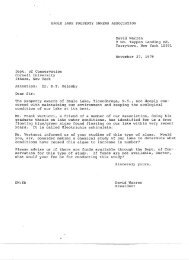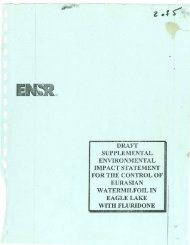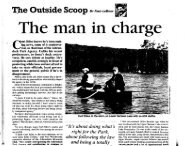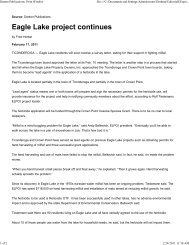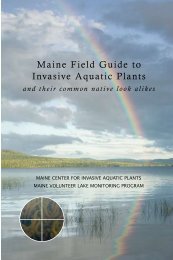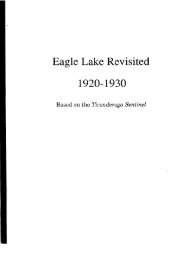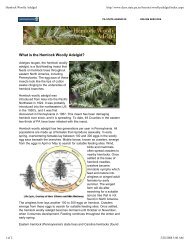Adirondack Park - Eagle Lake Property Owner's Inc.
Adirondack Park - Eagle Lake Property Owner's Inc.
Adirondack Park - Eagle Lake Property Owner's Inc.
You also want an ePaper? Increase the reach of your titles
YUMPU automatically turns print PDFs into web optimized ePapers that Google loves.
Curlyleaf pondweed (Potamogeton crispus)<br />
While some pondweeds (genus Potamogeton) are native, curlyleaf pondweed is a submerged<br />
aquatic plant from Europe, apparently introduced to the U.S. in the 1800’s. It somewhat<br />
resembles the numerous native pondweeds present in <strong>Adirondack</strong> waters. Curlyleaf pondweed is<br />
the only pondweed that has leaves with toothed, jagged edges. Leaves are alternating, reddishgreen,<br />
and stiff. Their wavy edges resemble lasagna noodles. The stems are branched and<br />
somewhat flattened. Curlyleaf pondweed produces overwintering buds called turions. They look<br />
like miniature floral arrangements and are hard and prickly. Curlyleaf pondweed exhibits rapid<br />
early season growth giving it a competitive advantage over native plants.<br />
(info at http://www.adkinvasives.com/Aquatic/PlantID/Pondweed.html)<br />
Fanwort (Cabomba caroliniana)<br />
Fanwort a native to the southeastern U.S., but has invaded ponds, lakes and quite streams in the<br />
northeast, including four lakes in the southwestern <strong>Adirondack</strong>s. As with other non-native<br />
aquatics, it likely spread via aquarium releases. Like Eurasian milfoil, this pest can re-grow from<br />
fragments. This submersed macrophyte have both submersed and floating leaves of different<br />
shapes. Fanwort generally grows in three to ten feet of water, however, in the <strong>Adirondack</strong>s, it<br />
grows in much deeper water, suggesting it is highly adaptable to environments outside its normal<br />
range.(from:http://aquat1.ifas.ufl.edu/cacapic.htmland<br />
http://www.adkinvasives.com/Aquatic/PlantID/Fanwort.html)<br />
Japanese knotweed (Fallopia japonica)<br />
Japanese knotweed, a semi-woody perennial plant, was likely introduced to the United States<br />
from eastern Asia as an ornamental in the late 1800s. While technically a terrestrial species,<br />
Japanese knotweed is commonly found around water sources and has become a dominant species<br />
along substantial stretches of rivers and streams throughout much of the <strong>Lake</strong> Champlain Basin.<br />
It also invades wetland areas (Shaw and Seiger, 2002). It spreads quickly, forming dense thickets<br />
in early spring that prevent the growth of native species and are of little value to wildlife. Annual<br />
die off of the plant leaves river and stream banks vulnerable to erosion. The plant’s spread is<br />
facilitated by flooding and the downstream flow of rivers. Japanese knotweed is a difficult plant<br />
to control due to its ability to reproduce both vegetatively and from seeds. Mechanical and<br />
chemical methods are most commonly used to eliminate it. Single young plants can sometimes<br />
be pulled by hand, but all roots and runners must be removed to prevent re-sprouting. The<br />
application of an herbicide to freshly cut stems has proven effective. The <strong>Adirondack</strong> <strong>Park</strong><br />
Invasive Plant Program is coordinating a Japanese knotweed management program within the<br />
<strong>Adirondack</strong> <strong>Park</strong>.<br />
Water chestnut (Trapa natans)<br />
Water chestnut, an annual aquatic plant native of Europe, Asia, and Africa was first documented<br />
in <strong>Lake</strong> Champlain in the early 1940s in shallow bays in the southern end on both the Vermont<br />
and New York shores. It is generally assumed that water chestnut seeds hitchhiked to <strong>Lake</strong><br />
Champlain on boats traveling through the Champlain Barge Canal from the Mohawk or Hudson<br />
River where it had been previously established (Countryman, 1970). Water chestnut displaces<br />
other aquatic plant species, is of little food value to wildlife, and forms dense mats that alter<br />
habitat and interfere with recreational activities. Currently, extensive growth of water chestnut in<br />
southern <strong>Lake</strong> Champlain severely restricts boat traffic and other recreational uses. Populations<br />
22



